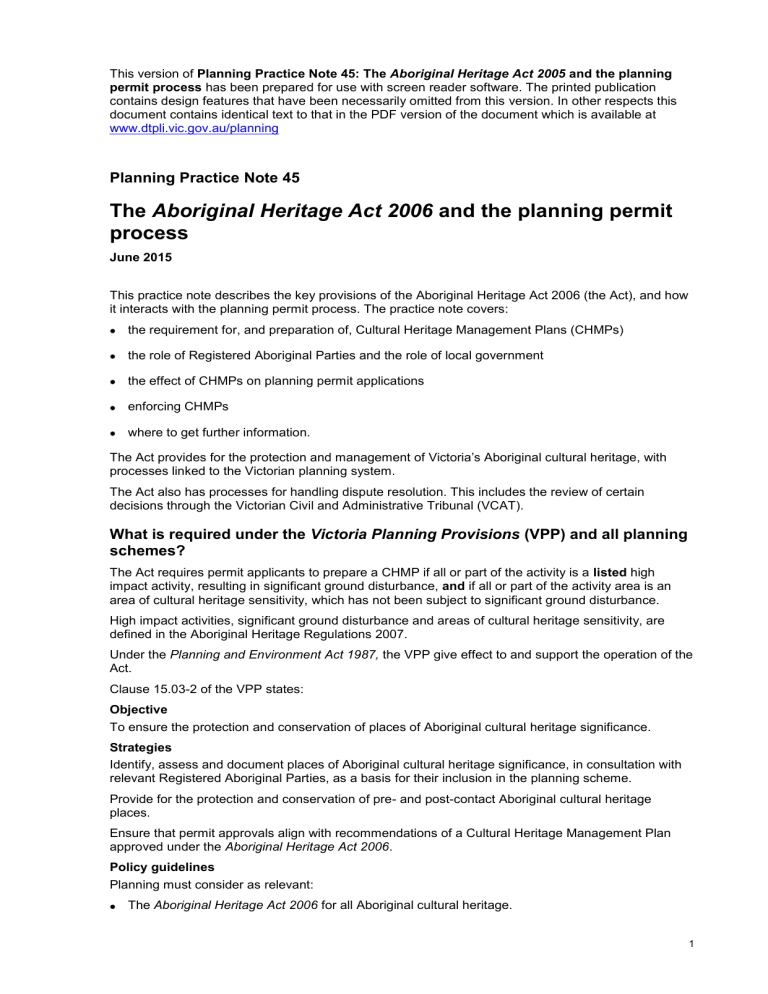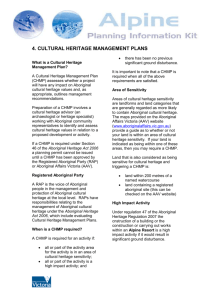Aboriginal Heritage Act 2006 and the Planning Permit Process

This version of Planning Practice Note 45: The Aboriginal Heritage Act 2005 and the planning permit process has been prepared for use with screen reader software. The printed publication contains design features that have been necessarily omitted from this version. In other respects this document contains identical text to that in the PDF version of the document which is available at www.dtpli.vic.gov.au/planning
Planning Practice Note 45
The Aboriginal Heritage Act 2006 and the planning permit process
June 2015
This practice note describes the key provisions of the Aboriginal Heritage Act 2006 (the Act), and how it interacts with the planning permit process. The practice note covers:
the requirement for, and preparation of, Cultural Heritage Management Plans (CHMPs)
the role of Registered Aboriginal Parties and the role of local government
the effect of CHMPs on planning permit applications
enforcing CHMPs
where to get further information.
The Act provi des for the protection and management of Victoria’s Aboriginal cultural heritage, with processes linked to the Victorian planning system.
The Act also has processes for handling dispute resolution. This includes the review of certain decisions through the Victorian Civil and Administrative Tribunal (VCAT).
What is required under the Victoria Planning Provisions (VPP) and all planning schemes?
The Act requires permit applicants to prepare a CHMP if all or part of the activity is a listed high impact activity, resulting in significant ground disturbance, and if all or part of the activity area is an area of cultural heritage sensitivity, which has not been subject to significant ground disturbance.
High impact activities, significant ground disturbance and areas of cultural heritage sensitivity, are defined in the Aboriginal Heritage Regulations 2007.
Under the Planning and Environment Act 1987, the VPP give effect to and support the operation of the
Act.
Clause 15.03-2 of the VPP states:
Objective
To ensure the protection and conservation of places of Aboriginal cultural heritage significance.
Strategies
Identify, assess and document places of Aboriginal cultural heritage significance, in consultation with relevant Registered Aboriginal Parties, as a basis for their inclusion in the planning scheme.
Provide for the protection and conservation of pre- and post-contact Aboriginal cultural heritage places.
Ensure that permit approvals align with recommendations of a Cultural Heritage Management Plan approved under the Aboriginal Heritage Act 2006 .
Policy guidelines
Planning must consider as relevant:
The Aboriginal Heritage Act 2006 for all Aboriginal cultural heritage.
1
The findings and recommendations of the Aboriginal Heritage Council.
The findings and recommendations of the Victorian Heritage Council for post-contact Aboriginal heritage places where relevant.
What does a responsible authority have to do?
A responsible authority must check whether a CHMP is required prior to determining a planning permit application, referred to as a statutory authorisation.
A request to rezone land does not trigger a requirement to prepare a CHMP. A preliminary cultural heritage assessment is strongly recommended at this stage to identify any relevant constraints and opportunities that may assist in the rezoning of land.
If a CHMP is required, the responsible authority cannot issue a planning permit until it receives a copy of the approved CHMP (section 52(1) of the Act).
A planning permit cannot be granted for an activity that is inconsistent with an approved CHMP
(section 52(3) of the Act).
Responsible authorities may choose to include a note on the permit directing the proponent to the recommendations of the CHMP approved under the Act. This may be of assistance to proponents in identifying all compliance requirements for a project.
When is a CHMP required?
The person, company or agency that proposes an activity (the sponsor) is responsible for establishing whether their project requires a CHMP.
A CHMP is required for a proposed development if:
the proposal is a listed high impact activity that will cause significant ground disturbance and is in an area of cultural heritage sensitivity as defined by the Aboriginal Heritage Regulations 2007;
the activity requires an Environmental Effects Statement; or
the Minister for Aboriginal Affairs so directs.
CHMPs can also be prepared voluntarily.
High impact activities
High impact activities are specified in the Aboriginal Heritage Regulations 2007 (Part 2, Division 5), and generally include buildings and works that result in significant ground disturbance. The specified activities include, but are not limited to:
subdivisions of three or more lots;
the construction of three or more dwellings;
constructing roads, bicycle and walking tracks over 100m in length;
activities that require an Earth Resource Authorisation; and
industrial developments.
If the proposed activity is not a listed high impact activity it does not trigger a CHMP.
Areas of cultural heritage sensitivity
Areas of cultural heritage sensitivity are also specified in the Aboriginal Heritage Regulations 2007
(Part 2, Division 3). They include registered cultural heritage places, named waterways, coastal land, parks, stony rises, volcanic cones, caves, dunes, and land within specified distances of these areas of cultural heritage sensitivity.
The areas of cultural heritage sensitivity have been mapped and these maps are made available to councils, and can also be found on the Office of Aboriginal Affairs Victoria website.
If a n area of cultural heritage sensitivity has been subject to ‘significant ground disturbance’, the area may no longer be an area of cultural heritage sensitivity. For further information see the Aboriginal
2
Heritage Act 2006 practice note: Significant Ground Disturbance on the Office of Aboriginal Affairs
Victoria website.
Councils can also work with the Office of Aboriginal Affairs Victoria and Registered Aboriginal Parties to refine the sensitivity mapping to reflect conditions and land use history. These maps can then be included in Schedule 1 to the Regulations and take precedence over the statewide map.
What must a CHMP include?
A CHMP is a written report that assesses the nature of any Aboriginal cultural heritage present in an activity area. An assessment may include background research, consultation, field survey and excavation.
CHMPs must focus on minimising harm to cultural heritage, or managing any unavoidable impacts
(section 61 of the Act). They deal with cultural heritage identified during the assessment, denote areas where further heritage may be discovered during works and provide contingencies (agreed processes) for managing cultural heritage uncovered during works.
Who prepares the CHMP?
The sponsor is responsible for preparing a CHMP. The sponsor must engage a cultural heritage advisor to assist in preparation of a CHMP. The Office of Aboriginal Affairs Victoria maintains a list of
Cultural Heritage Advisors, which is accessible online.
What is the role of Registered Aboriginal Parties in approving CHMPs?
A Registered Aboriginal Party that nominates to evaluate a CHMP may also:
participate in the assessment of the area to determine the nature of cultural heritage present; and
consult with the sponsor on proposed cultural heritage management recommendations.
A Registered Aboriginal Party can only refuse to approve a CHMP on the cultural heritage management grounds listed under section 61 of the Act, or if the CHMP has not been prepared in accordance with the prescribed standards.
The sponsor may apply to VCAT for review of a Registered Aboriginal Party decision not to approve a
CHMP (section 116 of the Act).
VCAT can approve, amend or refuse to approve the CHMP. The local council is not required to be involved in this process.
What if other Aboriginal people object to a planning permit application?
Only Registered Aboriginal Parties (or the Secretary, Department of Premier and Cabinet) are able to evaluate (approve or reject) a CHMP. If there is more than one party, both have the same standing and are both able to evaluate the CHMP.
Other Aboriginal people, or organisations, have the same standing as any other potential objectors to planning permit applications.
Do amendments to existing planning permits require a CHMP?
Yes. Amendments to planning permits are statutory authorisations for which a CHMP may be required.
An assessment of whether the proposed activity is a high impact activity on land of cultural heritage sensitivity (that has not been subject to significant ground disturbance) is required.
However, amendments to planning permits where there is already an approved CHMP in place do not trigger a further CHMP if the amendments are consistent with the approved CHMP.
Who is responsible for enforcing a CHMP?
Once a CHMP is approved, the recommendations become compliance requirements. The Office of
Aboriginal Affairs Victoria is responsible for monitoring compliance with the Act and directing audits into the contravention of a CHMP.
Responsible authorities must ensure that activities authorised by a planning permit are consistent with the approved CHMP.
3
Further information:
The Office of Aboriginal Affairs Victoria
Tel: 1800 762 003 www.aboriginalaffairs.vic.gov.au
Email: aboriginal.heritage@dpc.vic.gov.au
The planning process and Cultural Heritage Management Plan requirement
Step 1: An applicant proposes an activity that requires a planning permit (for example, a large subdivision in a coastal area) and applies to the responsible authority for a planning permit.
Step 2: If the applicant has not provided an approved Cultural Heritage Management Plan (and one is required), the responsible authority notifies the applicant that a Cultural Heritage Management Plan is required under section 52 of the Act (with reference to the ‘triggers’ as outlined in the Regulations).
(If the applicant provides an approved Cultural Heritage Management Plan go directly to Step 7.)
Step 3: The applicant advises the relevant Registered Aboriginal Party or Parties for the area, and engages a cultural heritage advisor. The responsible authority is not required to be involved in this process.
Step 4: A Cultural Heritage Management Plan is prepared by the applicant, with the assistance of a cultural heritage advisor. Registered Aboriginal Parties may participate in this process.
Step 5: The Registered Aboriginal Parties endorse or reject the Cultural Heritage Management Plan.
(Rejection may be appealed to VCAT.)
Step 6: The applicant submits the approved Cultural Heritage Management Plan to the responsible authority.
Step 7: The responsible authority can then determine the planning permit application. The statutory time limit for assessing the planning permit application does not commence until the approved Cultural
Heritage Management Plan has been received. The responsible authority must not grant a planning permit if the proposed development is inconsistent with the approved Cultural Heritage Management
Plan (section 52 (3) of the Act.)
© The State of Victoria Department of Environment, Land, Water and Planning 2015
This work is licensed under a Creative Commons Attribution 4.0 International licence. You are free to re-use the work under that licence, on the condition that you credit the State of Victoria as author. The licence does not apply to any images, photographs or branding, including the Victorian Coat of Arms, the Victorian Government logo and the Department of Environment, Land, Water and Planning
(DELWP) logo. To view a copy of this licence, visit http://creativecommons.org/licenses/by/4.0/
Published October 2007, revised October 2013, republished June 2015
ISBN 978-1-74208-033-8 (pdf)
Disclaimer: This publication may be of assistance to you but the State of Victoria and its employees do not guarantee that the publication is without flaw of any kind or is wholly appropriate for your particular purposes and therefore disclaims all liability for any error, loss or other consequence which may arise from you relying on any information in this publication.
Accessibility: If you would like to receive this publication in an alternative format, please telephone
DELWP Customer Service Centre 136 186, email customer.service@delwp.vic.gov.au, via the
National Relay Service on 133 677 www.relayservice.com.au
. This document is also available in as a
PDF at www.delwp.vic.gov.au/planning
DOCUMENT ENDS
4








